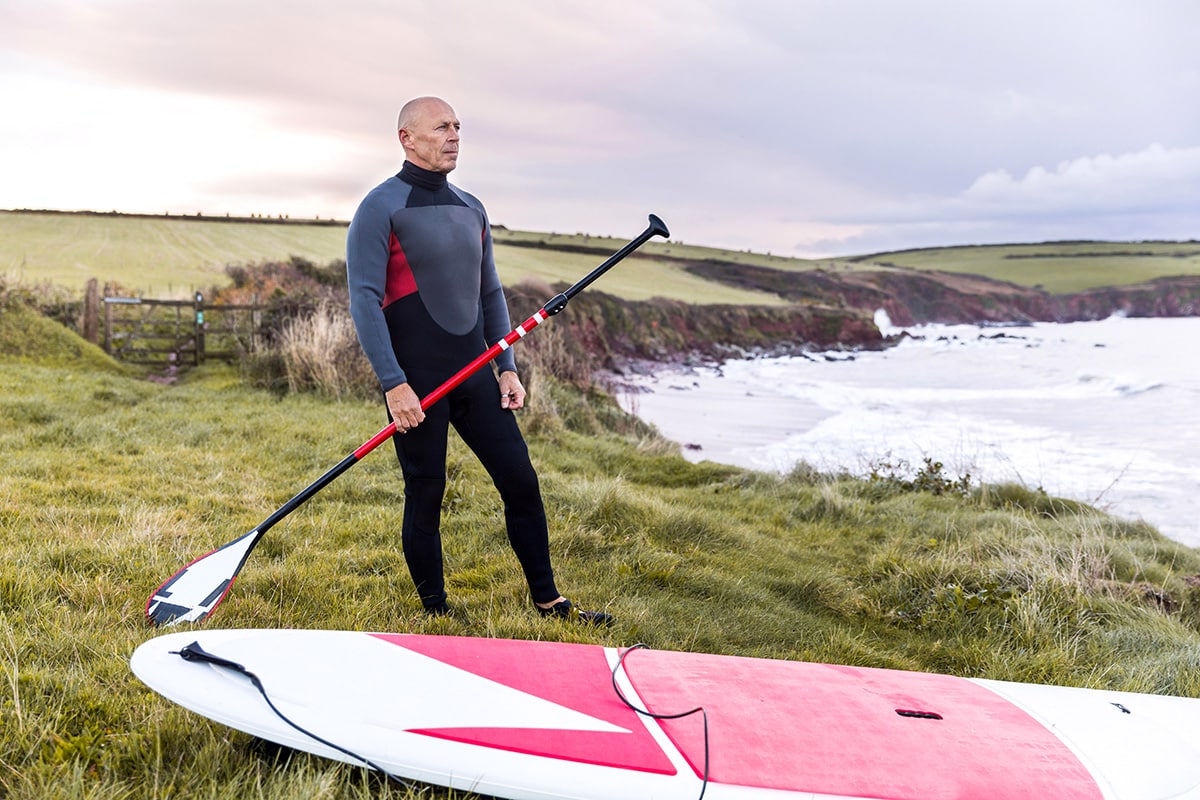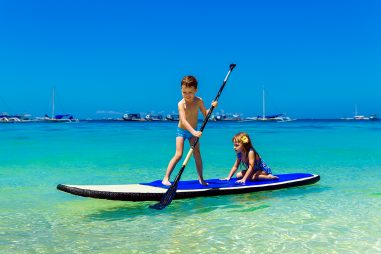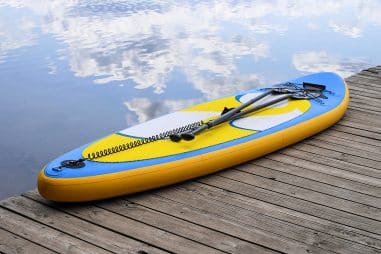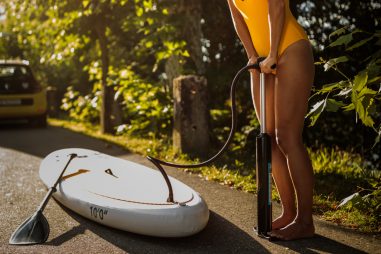You do not need a lot of gear when you go paddle boarding, and this is why it is such a no-fuss sport. The same is true when it comes to your paddle boarding attire. There are really no strict rules on what to wear (or what not to wear) because it all comes down to what you are comfortable with and what will keep you dry and warm. So, if you want to start paddle boarding, but you do not know where to start when it comes to your attire, then read on.
How Do You Stay Warm While Paddle Boarding?
For most water temperatures, a wetsuit can help you stay warm. They have different thickness that is appropriate for both warm and cold weather. And if you are planning to head out on a winter paddle boarding adventure, it is recommended to wear movable tops and pants or a thicker neoprene wetsuit.
Make sure that your winter paddle boarding attire is made of athletic fabrics so that it can keep you dry even if you get knocked off the water. When paddle boarding during the winter months, you have to remember that staying dry is the key to staying warm.
Do You Need a Wetsuit for Paddle Boarding?
Having a wetsuit is a must regardless of your chosen paddle boarding location. Wetsuits are comfortable, and they offer high mobility, making paddling easy even when you are wearing a full-length one.
Wetsuits also keep you dry and toasty, especially during the winter months. But you have to get the perfect size for your body type so that the water cannot get in and be trapped inside your wetsuit.
During the summer or the warmer months, you can opt to wear other garments like a swimsuit or rash guard. But it is still nice to wear a wetsuit because it can still protect you from the harsh elements of the water.
What Kind of Wetsuit Do I Need for Paddle Boarding?
Wetsuits come in many variations of thickness. This is because thinner ones are usually better for tropical destinations, while thicker ones are great for winter paddle boarding. During the winter months, you need to wear wetsuits that are at least 4 millimeters to 7 millimeters in thickness. This type of wetsuit will keep you warm even if you paddle board on an almost frozen lake.
If you are paddle boarding in warmer weather and warmer water temperature, it is suggested to get a wetsuit which is 3/2 millimeters. This type of wetsuit has a core that is 3 millimeters thick, while the outer parts like the legs and the arms are 2 millimeters in thickness.
What Is the Best Wetsuit for Paddle Boarding?
If you are on the lookout for a new wetsuit or if you are looking to replace your old ones, then you came to the right place. Here are some of the best paddle boarding wetsuits in the market today.
- Stohlquist Men’s Storm John Wetsuit: Made with 3 mm standard neoprene, the Stohlquist Men’s Storm John Wetsuit is a great wetsuit for stand up paddle boarding during the summer. It is a full-body wetsuit that comes in many sizes to ensure that you will find the perfect fit for you. The Storm John Wetsuit features SupraTex knees and a relief zipper with an elastic zipper lock.
- Hyperflex Access Wetsuit: This summer-friendly full-body wetsuit features a 3 mm lightweight neoprene. The Hyperflex Access Wetsuit has a 4-way stretch which makes it impressively flexible, and it also has a 50+ ultraviolet shield. It also has a flat lock inside seams which makes it comfortable even if you decide not to wear anything inside. The Hyperflex Access is great for paddle boarding and all sorts of water activities.
- Hevto Wetsuit: Made with 3 mm neoprene, the Hevto is a great summer and spring wetsuit option. It is constructed with nylon elastic fabric flat lock stitching and is designed with a fitting neckline. The Hevto offers both buoyancy and extreme flexibility. This wetsuit comes in many sizes, so we are sure that you can find your perfect size. It also offers an amazing UV shield so you would know that you are 100 percent protected from the harsh rays of the sun.
- NeoSport Wetsuit: This comfortable wetsuit comes in many sizes and thickness, which means wherever you want to go, there is a NeoSport wetsuit that is perfect for your adventure. These neoprene wetsuits come in 3/2 mm to 7/5 mm. The NeoSport has thermal-bonded knees, adjustable collars, lycra in the arm, waist, and neck openings, and to top it all off, an internal pocket! The NeoSport also comes in many colors, so you are sure to find a wetsuit for all your adventures.
- Dark Lightning Full Body Wetsuit: Made with 3/2 mm neoprene and stretch nylon, the Dark Lightning Full Body wetsuit is considered to be one of the best in the current market. The Dark Lightning wetsuit offers both comfort and flexibility, which makes it a good option not just for paddle boarding but also for other water activities such as surfing or scuba diving. It features a zipper and premium Velcro, and it also has flat lock stitching. What’s more, is that Dark Lightning comes in 25 different sizes! No matter what size you are, there is sure to be a Dark Lightning wetsuit perfect for you.
- OMGear Wetsuit: Made with 3 mm neoprene and stretch nylon, this summer-friendly wetsuit is not only comfortable, but it is also very, very stylish. It offers a 50+ ultraviolet shield that will surely protect you from the harmful rays of the sun. In addition, the OMGear is designed with a mock turtleneck that you can roll up to lessen the amount of water coming in. The OMGear is also great for swimming and scuba diving.
- Scubadonkey Aqua Polo Wetsuit: Made with a three-layer design, the Scubadonkey Aqua Polo wetsuit will surely protect you from the sun, the wind, and the water. It is made with 3/2 mm 4-way neoprene that is not just stretchable but it is also resistant to abrasions. The Scubadonkey is constructed with flat lock stitching, and it features neoprene gaskets around the neck, ankles, and wrists. These gaskets allow you to put on and take off the wetsuit very easily. To add to the many good things that Scubadonkey are, it is also one of the most affordable wetsuits in the market today.
- O’Neill Men’s Wetsuit: This high-end brand is made with 3/2 mm ultra stretch neoprene that is great for paddle boarding in warm water. O’Neill is a well-known wetsuit brand that offers comfortable and top-notch quality wetsuits. This wetsuit has a back zip system that makes putting it on and taking it off a breeze. It is also wind-resistant. It also comes in many different sizes, so you will surely find your perfect fit.
- Synergy Triathlon Wetsuit: The Synergy Triathlon wetsuit is made with 5 mm hydrodynamic neoprene. This women’s wetsuit features a thick and buoyant core that also acts as a flotation device in case of falls. This wetsuit fits like a second skin, and it offers high mobility and flexibility. It features an anti-corrosion internal zipper, smooth skin neckline, and it has triple stitched seams. The Synergy wetsuit comes in 19 sizes, so ladies, you can surely find your next professional wetsuit in this brand.
- Shorty Wetsuit: Made with a combination of neoprene and nylon fabric, the Shorty is a 3 mm thick wetsuit, which makes it a great option for paddle boarding in warmer temperatures. The Shorty features a heavy-duty front zip, flat lock stitching, and Velcro collar. It is also offering protection from both the harmful rays of the sun and the harsh water elements.
What Do You Wear Under a Wetsuit for Paddle Boarding?
If you got the perfect size of wetsuit for you, you do not really need to put on anything underneath anymore. The wetsuit will stick to your body like a second skin, and it will offer you high mobility, comfort, and flexibility. Wetsuits with well-made inside seams will also add to the comfort of being naked underneath.
That is not to say that you should always go commando on your wetsuit. If you prefer, you can always wear garments underneath your wetsuit, especially if you are concerned about hygiene and your private parts. Aside from that, the garments you wear underneath your wetsuit will also add warmth and protection. Here are some of the options to wear underneath your wetsuit:
- Diving or bicycle short that has to be the perfect fit for your body
- Rash guard
- Lycra or nylon fiber briefs (for men)
- Sleeveless vest suitable for layering under wetsuits
- One-piece swimsuit
- Two-piece swimsuit
On the other hand, if it is chafing that you are worried about, there are many anti-chafing gels in the market that you can apply to your body to remedy this.
What Do You Wear on Your Feet Paddle Boarding?
There are many options on what you can wear on your feet when you go paddle boarding. However, many paddle boarders just go barefoot on their board, especially if they are in warmer countries. During the winter months, paddle boarders usually go for neoprene boots to keep their feet warm.
There are also other options such as trainers, waterproof socks, flip flops or slippers, and wellies or rubber boots. All of these have their own pros and cons. As you progress in the sport, you can gauge what option will keep your feet warm and dry.
Do You Wear Shoes When Paddle Boarding?
If you are paddle boarding in the winter, you should definitely wear shoes to cover your feet. The shoes will keep your feet warm and dry, and they will also avoid frostbite, especially if you like paddle boarding in frozen waterways. When paddle boarding in the winter months, one of the most important things to remember is to keep your feet dry because this will also keep you warm.
This is not that much of a problem when paddle boarding in much warmer countries. In these locations, most paddle boarders go barefoot or just opt to wear their slippers.
What Shoes Do You Wear for Paddle Boarding?
If you are paddle boarding in the winter or in colder countries with colder water temperatures, here are some of the options of shoes that you can choose from to keep your feet dry, warm, and toasty.
- Neoprene boots: This is the most popular option of shoes to wear when paddle boarding during the winter months. These boots offer warmth and protection even when you paddle in frozen lakes. It also has room so your toes can move comfortably, which helps you in balancing. Neoprene boots also dry very quickly. They also come in varying thickness, and you can choose anything between 2 millimeters to 8 millimeters. It should be noted, though, that neoprene boots are more effective for shorter paddle boarding adventures. The cold can still seep in the boots, especially if you paddle for much longer.
- Trainers: While fewer people wear this, you can also use trainers when paddle boarding. It is a good option because it provides your feet protection, especially during launch. It also helps in keeping your feet warm, but in order to be effective, they have to always remain dry. One bad thing about trainers, when used in paddle boarding, is that they are not waterproof and they do not have drainages, so if you fall in the water, not only will your feet become cold, the trainers will also be waterlogged.
- Wellies or rubber boots: This is a great option since you can walk through the water before the launch. The thing is, you can only go up to a certain distance just before the water reaches the opening of the wellies. It is also not recommended to wear wellies while you are paddle boarding because they can fill with water when you fall in. What’s recommended is that you take it off and stash it on the board once you are on top of your paddle board.
Do You Need Water Shoes for Paddle Boarding?
You definitely need to wear water shoes for paddle boarding, especially if you are one of those paddlers who enjoy doing the sport even in the winter. Water shoes will keep your feet dry and warm. They will also help you avoid frostbite when you fall in very, very cold water.
On the other hand, if you are in the tropics where the water is warmer, you can skip the water shoes and just go barefoot as most paddlers would. If you go barefoot, your feet will be free, and it can help you keep your balance better.
Should I Wear Shoes When Paddle Boarding?
The answer to this question highly depends on your chosen location or the water temperature. If you personally like paddle boarding during the winter months, then wearing shoes is a must! Shoes will keep your feet dry, warm, and they will help in avoiding frostbite. Your options when you go paddle boarding in the winter include neoprene boots, trainers, and wellies.
Most paddle boarders skip the shoes altogether, especially if they are in much warmer countries with warm water temperatures. Going barefoot on your board is usually the way to go because this helps in maintaining their balance on the board, especially if you are a beginner.
At most, paddle boarders in tropical countries wear their flip flops or slippers. They offer protection for when you are launching, and they are also very easy to put on and remove. However, slippers offer no warmth whatsoever.
What Do You Wear for Paddle Boarding in the Summer?
Summer is probably the easiest season to dress for, especially in terms of your paddle boarding attire. During the summer, the weather, wind, and water are usually hot, so keeping warm is the least of your concern. You can just opt to wear light layers for both your comfort and mobility. Here are some of the options that you can choose from when you want to go paddle boarding in the summer.
For Women:
- Swimsuit (either one-piece or two-piece)
- Light overshirt
- Rash guard
- 3 mm wetsuit
For Men:
- Swim trunks
- Board shorts with draw string
- Rash guard
- T-shirt
- Light long sleeve shirts
You can also wear hats to protect your face and sunglasses to protect your eyes. No matter what you choose to wear, be sure not to skimp on sunblock.
Do You Paddle Board Barefoot?
Most paddle boarders often go barefoot, especially when they are in the tropics, where the weather is nicer and the water is warmer. There are pros to paddle boarding barefoot. For one, your feet will be freer. It will also help your balance on your board better.
If you are scared of hurting your feet on a rock when you fall into the water, you can always choose to wear your slippers. They are great for launching, and they are also easy to put on and remove from your feet.
What Do You Wear When Paddle Boarding in Cold Weather?
You definitely need more layers if you want to paddle board in a place where the weather is cold. For starters, you can wear a thicker wetsuit (anything from 4 mm to 7 mm in thickness), but you need more than that. Wear movable thermal tops and bottoms on top of your wetsuit. Make sure that they are constructed with athletic fabrics to keep you dry.
You can also wear dry suits, especially if you will be paddle boarding in cold water, which is less than 45 degrees Fahrenheit. Drysuits are constructed with waterproof coating, and they often feature zippers that keep the water outside and gaskets at the ankles, neck, and wrists. However, dry suits will only keep you dry but not warm, so be sure to wear thermal clothes on top.
Make sure to wear your neoprene booties. They will keep your feet warm, and they dry relatively fast. Choose one with thinner soles so you can feel the grips on your board better.
You should also definitely wear gloves, and you can choose from neoprene or wool. Both are great in keeping your fingers and hands warm, but neoprene gloves are way more expensive.
What Do You Wear for Paddle Boarding in the Spring?
It is usually tricky to pick what to wear during the Spring or Fall since these are transitional seasons. Your usual summer attire won’t cut it because of the cold, but your thermal tops and bottoms will probably be too hot and uncomfortable.
What’s recommended is to wear your usual summer outfit (swimsuit, rash guard, light shirt, etc.) and layer it with a thicker wetsuit and waterproof jacket. If you think you can handle it, you can also wear dry active wear on top of your summer attire instead of a waterproof jacket. You can always layer up or layer down, depending on the temperature in your chosen location.
One thing is for sure, though; it would be unwise to go barefoot during the Spring as the water will still be cold. Choose neoprene booties instead so you can keep your feet nice and warm while also maintaining a good grip on your board.
What Do You Wear for Paddle Boarding in the Fall?
Whatever you wear during paddle boarding in the Spring is pretty much the same outfit to go for during the Fall. You can layer your swimsuit, rash guard, or light shirt with a thicker wetsuit. You can also put on either a waterproof jacket or quick-drying active wear. You can also add more layers if you are prone to the cold.
Do not forget your feet, and make sure that you wear neoprene boots. These will protect your feet from the cold, and they will keep your feet dry. You can always mix and match depending on the outside temperature on your location of choice.
What Should I Wear to Paddle Board in the Winter?
Some people enjoy the thrill of paddle boarding in the winter, and if you are one of them, then you know that keeping warm and dry is the top priority. It is recommended to wear a full-length wetsuit which you can layer with thermal and waterproof tops and bottoms.
Here is a quick guide on which wetsuit will best serve you depending on the temperature:
- If the temperature is around 50 degrees Fahrenheit or 10 degrees Celsius, choose a 4 mm wetsuit.
- If the temperature is around 30 degrees Fahrenheit or -1 degrees Celsius, choose a wetsuit between 4 to 5 mm.
- If the temperature is around 10 degrees Fahrenheit or -12 degrees Celsius, choose a wetsuit between 5 to 6 mm.
Also, make sure that you wear your gloves (either neoprene or wool) and your neoprene boots. These will keep your extremities warm and dry and will help avoid frostbite.
It is also advisable to layer on clothes, especially if you are very prone to the cold. It will also be great if you try hard not to fall in the water or to splash water on your clothes.
What Do You Do With Your Keys When Paddle Boarding?
If you are not comfortable leaving your keys on land when you go paddle boarding, there are many ways to keep them with you while you are in the water. Here are some ideas on how to hold on to your keys while paddle boarding:
- Keep them in the zippered pockets of your wetsuit or personal flotation device like life jackets.
- Keep them in a dry bag that you can bring will paddle boarding.
- Keep them in a Ziplock bag and hide them in your pocket or the inside of your wetsuit.
- Keep them in a waterproof phone case that you can wear around your neck or inside your wetsuit.
Just for good measure, you can attach a floating keychain to your keys. This way, even when they fall in the water, they will float, and you can easily retrieve them.
What Else Should I Bring for Paddle Boarding?
You only need a few basic things when you go paddle boarding (paddle board, paddle, leash, and fins), but here are other optional gears that you can take with you on your paddle boarding adventure:
- Personal flotation device or PFD (such as life jacket or inflatable belt)
- Rescue whistle
- Lighting device (such as headlamp or flashlight)
- Towline
- Dry bags
- GPS
- Two-way radio
- Knife
- Waterproof case
- Compass
- First-aid kit
- Sunblock, hat, and glasses







